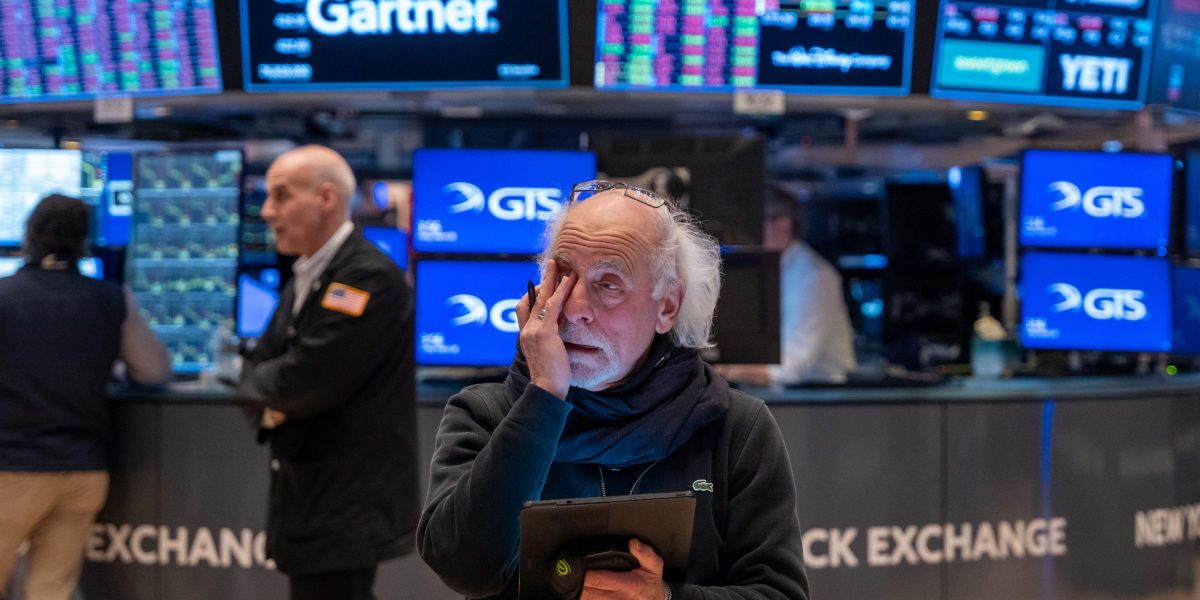- President Donald Trump has changed his tune again on tariffs as investors nervously await a new batch of import taxes to be unveiled on Wednesday. The stock market has had an especially tough March, and a quiet period for earnings has meant bad news out of Washington looms even larger than normal.
Stocks are set to post their worst quarter in nearly three years as markets wait in fear for President Donald Trump’s next big tariff announcement on Wednesday. The S&P 500 fell sharply after the opening bell, dipping below the 5,500 mark for the first time since September, before bouncing back to pare its losses. The index is down over 5% year to date, its worst three months since plunging 17% in the second quarter of 2022.
Wall Street has especially soured on tech as investors hunt for safer assets amid tariff turmoil. The Nasdaq Composite was down over 1% as of midday Monday and has fallen more than 11% in the first quarter of 2025. Shares of the market’s preeminent AI darling, Nvidia, have shed nearly a quarter of their value as the stock dipped Monday, while Elon Musk’s Tesla is down over 30% this year after its shares also fell.
Markets had received a boost last week after Trump downplayed expectations for the tariff announcement on April 2, which he has termed “Liberation Day.” The tune from the administration has changed again, however, with the Wall Street Journal reporting over the weekend that a blanket 20% tariff on all imports is on the table. The White House has also pushed back on previous reports that so-called reciprocal tariffs on trading partners might be narrowed, with the president telling reporters Sunday the new taxes will target “all countries.”
Markets famously hate uncertainty, as the saying goes, and Trump’s on-again, off-again tariff threats have weighed on stocks for months. As Wednesday’s announcement looms, a lack of good news has also made things worse, said ETF and hedge-fund manager Jay Hatfield, CEO of Infrastructure Capital Advisors.
Core to Trump’s economic agenda, he said, is the idea that tariffs will pay for tax cuts elsewhere. While investors have been forced to contend with how higher taxes on imports could result in slower growth and higher prices, there haven’t been as many updates from Washington about reducing the tax burden for individuals or corporate America.
“The bad part is pretty certain,” Hatfield said, “but the good part is not certain.”
Stocks initially rallied to all-time highs after Trump’s election win in November thanks to the president’s promises of tax cuts and deregulation unleashing economic growth.
“Not because he was going to try to make Canada the 51st state,” Hatfield said.
Seasonality could exacerbate recession fears
Those postelection gains have been more than erased after both the S&P and Nasdaq slid into correction territory in March. Tariff worries have fanned the flames of recession fears. Goldman Sachs now says there is a 35% chance of gross domestic product contracting for two straight quarters, in part because of how heavy import taxes could weigh on consumer spending and continued uncertainty might suppress business investment.
Cuts to the federal workforce, meanwhile, will also impact Friday’s monthly jobs report, and Hatfield would not be surprised if it came in soft. However, that could be bullish for the stock market long-term, he said, if it pushes the Federal Reserve to cut interest rates.
He also noted bonds rallied Monday as investors piled into safe-haven assets. The yield on the 10-year Treasury, the benchmark for rates on mortgages and other borrowing costs throughout the economy, now sits at 4.23%, down about 60 basis points from early January.
Finally, Hatfield also said March is typically a weak month for the stock market, in part owing to a lack of major earnings announcements to combat bad news.
“It’s kind of like waking up in the middle of night,” he said. “You don’t usually wake up euphoric. You wake up with your fears.”
Plenty of investors are hoping their tariff nightmare ends soon.
This story was originally featured on Fortune.com
Source link

 Entertainment8 years ago
Entertainment8 years ago
 Politics8 years ago
Politics8 years ago
 Entertainment8 years ago
Entertainment8 years ago
 Entertainment8 years ago
Entertainment8 years ago
 Tech8 years ago
Tech8 years ago
 Tech8 years ago
Tech8 years ago
 Tech8 years ago
Tech8 years ago
 Politics8 years ago
Politics8 years ago







